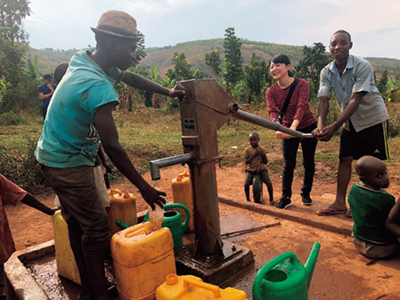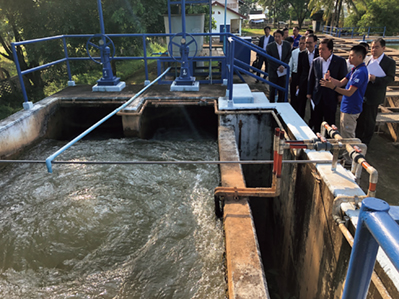(2) Water and Sanitation
Water and sanitation are vital issues linked to human life. Throughout the world, approximately 2.2 billion people are not provided with safely-managed drinking water, 4.2 billion people cannot use safely-managed sanitary facilities such as toilets, and three billion people live without access to basic hand-washing facilities. The lack of access to safe water also impedes economic growth. For example, in developing countries where piped water is not widely available, in many cases women and children bear the role of fetching water. Sometimes, spending many hours for this work deprives children of opportunities for education, and women of engaging in society. Furthermore, an unstable supply of water has a negative impact on healthcare and agriculture. From this viewpoint, Goal 6 of the SDGs sets forth the target “Ensure availability and sustainable management of water and sanitation for all.”

A Japan Overseas Cooperation Volunteer (JOCV) giving instruction on well maintenance and management while drawing water with local residents in Rwanda (Photo: JICA)
●Japan’s Efforts

State Minister for Foreign Affairs WAKAMIYA Kenji (third from right) visiting the Chinaimo water treatment plant located in the southern part of Vientiane, the capital of Laos, which was improved with ODA from Japan (October 2019)
Japan’s support has the top cumulative track record in the world in the fields of water and sanitation since the 1990s. Japan draws on its extensive experience, knowledge, and technology in these fields to provide continuous support for promoting the provision of safe water in developing countries, through the means of ODA loan and grant aid, as well as technical cooperation, including the dispatch of experts and accepting trainees from developing countries. Japan also provides support through international organizations such as UNICEF. Specifically, it provides support in both the soft (non-physical) and hard (physical) aspects, including the following: (i) promotion of integrated water resources management, (ii) provision of safe drinking water and basic sanitation through the improvement of sanitation facilities, (iii) support to ensure a stable use of water for agriculture to increase food production, (iv) water pollution prevention such as establishing effluent regulations, etc., and ecosystem conservation through tree planting and forest preservation, and (v) establishment of an early warning system to mitigate damage due to water-related disasters, strengthening the disaster response capacities of communities, and other purposes.
In the Asia and Oceania regions, Japan implemented projects for the development and expansion of piped water in Indonesia, Cambodia, Viet Nam, and Laos. For example, in October 2019, Japan and Laos signed the Exchange of Notes for a grant aid to improve water supply services, including the construction of new water pipes in Luang Prabang City, which has a World Heritage Site. It is expected that this cooperation will contribute to the development of a sustainable urban environment by increasing the population covered by the city’s water supply from approximately 58,800 people in 2017 to around 70,000 people in 2025, three years after the completion of the project. In addition, in December 2019, Japan and Cambodia signed an Exchange of Notes for a grant aid to expand water supply facilities in Pursat City, which has a particularly low water supply coverage rate even among the rural cities in Cambodia. This cooperation is expected to contribute to improving the quality of life in Cambodia through enabling access to safe water for approximately 100,000 residents in the region.
Moreover, in Africa, Japan is implementing projects aimed at improving access to safe water and enhancing the water supply rate. For example, Japan signed an Exchange of Notes for a grant aid to provide water supply and water treatment equipment (water trucks, water tanks, etc.) to Eritrea where challenges lie in the deterioration of water supply facilities and equipment. Japan has also signed an Exchange of Notes for a grant aid to provide mobile sea water desalination equipment, water trucks, etc., in order to improve access to safe water during disasters in Cabo Verde.
In addition, projects for improving water supplies and hygiene are implemented by Japanese NGOs through the Grant Assistance for Japanese NGO Projects. For example, Peace Winds Japan, a non-profit organization, is working on a project to improve access to water through the construction of water supply facilities with the participation of local residents in Sindhupalchok District, Nepal. The District was affected by the earthquake that occurred in February 2018 and faces water shortages including drying-up water sources. In the first year of the project, water supply facilities – nine water intakes, eight water storage tanks, and 52 public taps – were constructed in eight villages in Nepal.
In parallel with these efforts, Japan is also implementing a large number of assistance in the field of water and sanitation that directly benefit local residents, such as the improvement of wells, water supply, and irrigation facilities, as well as disaster prevention measures through the Grant Assistance for Grass-Roots Human Security Projects. For example, Japan provided excavators to the local government in Tajikistan through the Project for Provision of Excavators for Reinforcing Riverbanks in the Temurmalik Administrative District of Tajikistan. Through this project, embankments are being constructed using the provided equipment, which contributes to the prevention of flood damage due to meltwater and expansion of cultivated land.
Efforts for the improvement of the water environments in developing countries in cooperation with Japanese and local private companies and organizations are also being carried out around the world (see also “Master Techniques from Japan to the World”). For example, in Oceania, using JICA’s Framework for Supporting Japanese SMEs in Overseas Business (now referred to as the SDGs Business Supporting Surveys), a model formulation survey was conducted in Papua New Guinea regarding a project to sell drinking water to residents using energy-efficient compact seawater desalinization equipment. Through this study, it was confirmed that the project met local needs, leading to the successful start of sales of the equipment.
In addition, in order to eliminate the lack of local information and knowledge with regard to the problem of serious water contamination in many Asian countries, the Ministry of the Environment (MOE) is implementing the Water Environment Partnership in Asia (WEPA). With the cooperation of the 13 participating countries(Note28) from Asia, WEPA aims to enhance water environment governance in Asia through building human networks, gathering and sharing information, and capacity building. Moreover, to contribute to achieving “halving the proportion of untreated wastewater” that is raised in Target 6.3 of the SDGs, Japan is also encouraging the spread of septic tanks in developing countries through initiatives that introduce the technology of septic tanks, and legislative systems, etc. by holding workshops and seminars concerning Japan’s advanced septic tank technology, mainly for Asian regions.
- Note 28: The 13 countries are Cambodia, China, Indonesia, Republic of Korea, Laos, Malaysia, Myanmar, Nepal, Philippines, Sri Lanka, Thailand, Viet Nam, and Japan.
